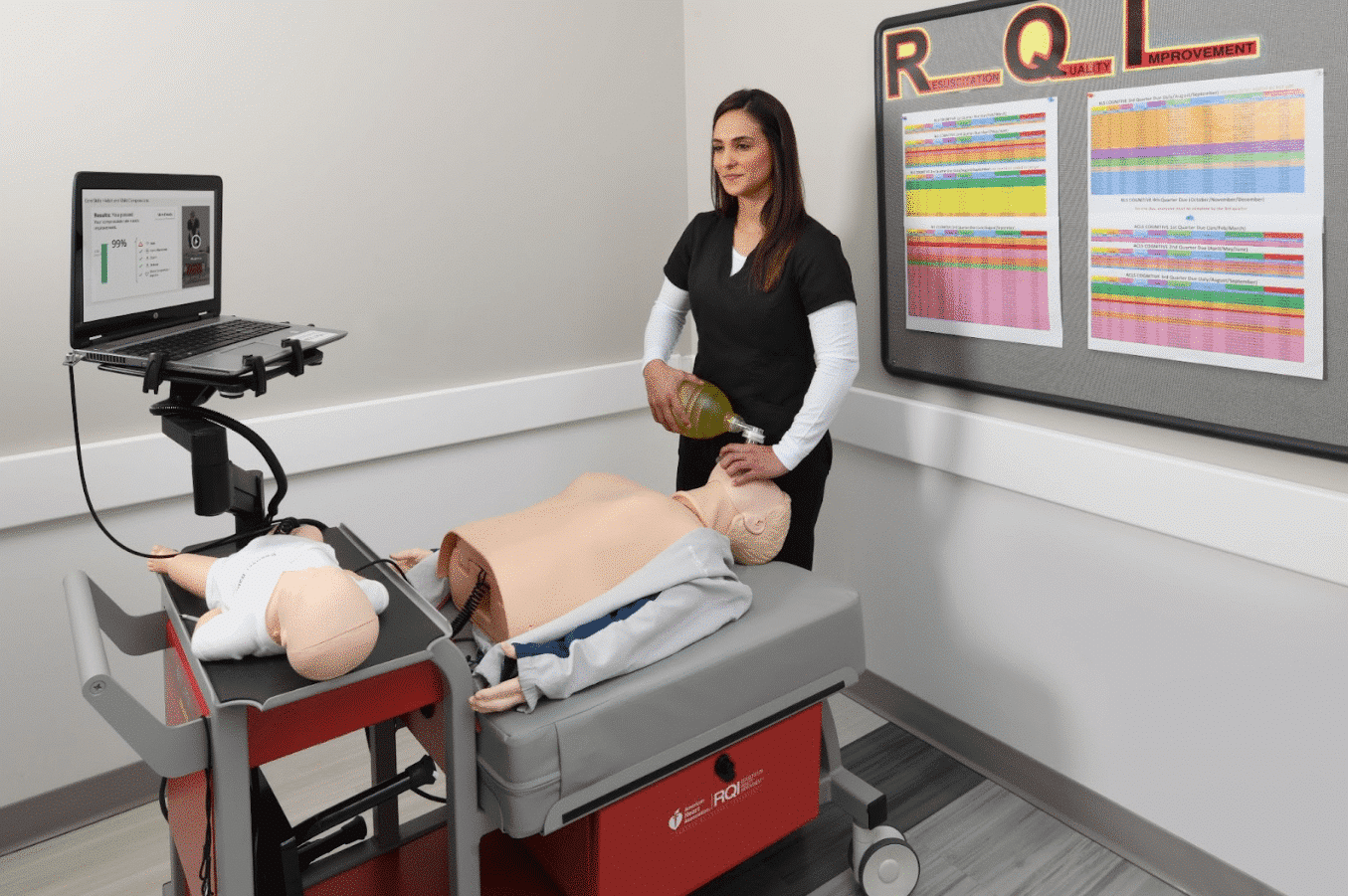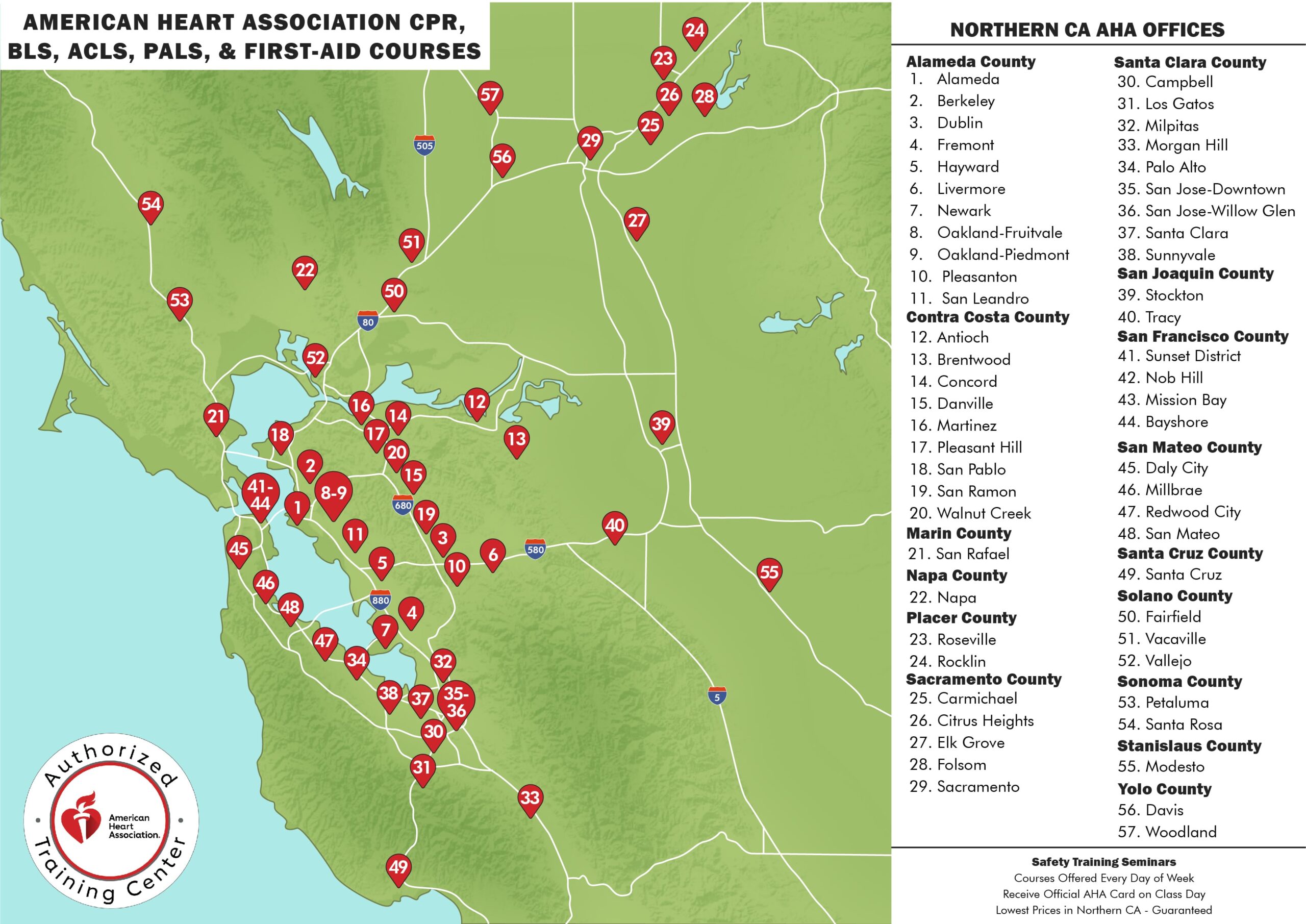
American Heart Association Course Registration
Safety Training Seminars offers American Heart Association CPR, BLS, ACLS, and PALS courses in Walnut Creek, CA. This office is close by the surrounding cities of Concord and San Ramon. If you live in Walnut Creek, you can take a BLS, ACLS, or PALS course near you. We can teach CPR & First-aid classes at your location any day of the week. Ask us about our group discounts.
What is American Heart Association RQI
The American Heart Association RQI (Resuscitation Quality Improvement) program is one of the most popular, modern, and efficient ways for medical and healthcare professionals to receive their official American Heart Association BLS, ACLS, and PALS certification cards.
Three Easy Steps
1. Take the American Heart Association online course at home (a few hours).
2. Arrive to one of our 45 local offices and practice with the VAM (voice assisted manikin).
3. Receive your certification card on the day of the class.

About American Heart Association RQI
Entry Instructions for Walnut Creek CPR Classroom
Walnut Creek, California Medical Facilities: A Hub of Healthcare Excellence
Walnut Creek, California, nestled in the heart of Contra Costa County, is not just known for its picturesque landscapes and vibrant culture; it’s also renowned for its top-notch medical facilities. With a strong commitment to providing exceptional healthcare services, this city has emerged as a hub of medical excellence in the San Francisco Bay Area.
Healthcare Pioneers
Walnut Creek boasts a wide array of medical facilities that cater to the diverse healthcare needs of its residents and visitors. These institutions are often at the forefront of medical innovation and research, ensuring that patients receive the most advanced and effective treatments available.
One of the standout facilities in the city is the John Muir Medical Center. This renowned institution is consistently recognized for its high-quality patient care, cutting-edge technology, and commitment to medical research. With a broad range of specialties, including cardiology, oncology, and neurosurgery, the John Muir Medical Center has earned a stellar reputation for providing world-class healthcare.
Comprehensive Care
What sets Walnut Creek’s medical facilities apart is their commitment to providing comprehensive care. These institutions offer a wide range of services, from routine check-ups to complex surgical procedures. Patients can expect to find everything they need under one roof, ensuring convenience and continuity of care.
Walnut Creek also boasts an impressive network of primary care physicians, specialists, and urgent care centers, ensuring that residents have easy access to medical services when they need them most. Whether it’s a routine wellness check or emergency medical attention, the city’s healthcare infrastructure is designed to meet all requirements promptly.
Innovation and Research
Walnut Creek’s medical institutions are not content with just providing standard medical care. They are also hubs of innovation and research. Many of these facilities collaborate with universities and research organizations to advance medical knowledge and develop new treatments.
For instance, the Kaiser Permanente Walnut Creek Medical Center is known for its dedication to research and innovation. Their commitment to staying at the cutting edge of medical science allows patients to access groundbreaking treatments and therapies that may not be available elsewhere.
Patient-Centered Approach
One of the defining characteristics of Walnut Creek’s medical facilities is their patient-centered approach. The staff at these institutions are known for their compassion and commitment to providing the highest level of care. Patients are not just medical cases; they are individuals with unique needs and concerns.
Furthermore, the facilities in Walnut Creek prioritize patient education. They go the extra mile to ensure that patients understand their conditions, treatment options, and how to maintain their health. This emphasis on patient empowerment contributes to better health outcomes and an overall positive healthcare experience.
Community Engagement
The medical facilities in Walnut Creek are deeply ingrained in the local community. They frequently host health fairs, workshops, and outreach programs to promote health and wellness among residents. These efforts not only help prevent illness but also foster a strong sense of community and support among the city’s residents.
Conclusion
Walnut Creek, California, is more than just a picturesque city; it’s a place where healthcare excellence thrives. With a commitment to comprehensive care, innovation, patient-centered approaches, and community engagement, the medical facilities in this city set a high standard for healthcare services. Whether you’re a resident or just passing through, you can rest assured that Walnut Creek’s medical institutions are ready to provide top-notch care, ensuring your health and well-being are in good hands.
Life-Saving Skills: Exploring CPR, BLS, ACLS, and PALS Classes
In the realm of emergency medical care, few skills are as crucial as Cardio-Pulmonary Resuscitation (CPR) and Advanced Cardiac Life Support (ACLS), Basic Life Support (BLS), and Pediatric Advanced Life Support (PALS) techniques. These life-saving techniques form the backbone of first response and medical intervention, often making the difference between life and death in critical situations. Let’s delve into the significance of each of these classes and their role in maintaining public health and safety.
Cardio-Pulmonary Resuscitation (CPR): CPR is a fundamental life-saving technique that can be administered by trained individuals to sustain blood circulation and provide artificial respiration when a person’s heart has stopped beating. CPR involves a combination of chest compressions and rescue breaths, aimed at keeping oxygenated blood flowing to vital organs until professional medical help arrives. CPR classes provide participants with the skills to recognize cardiac arrest, perform effective chest compressions, and deliver rescue breaths. These classes are vital for both medical professionals and laypersons, empowering them to respond swiftly and effectively in emergencies.
Basic Life Support (BLS): BLS takes CPR skills to the next level by incorporating additional techniques and equipment usage. BLS classes are designed for healthcare providers, including doctors, nurses, paramedics, and emergency medical technicians (EMTs). Participants learn how to assess a patient’s condition, deliver high-quality CPR, and use automated external defibrillators (AEDs) to restore a regular heartbeat. BLS training emphasizes teamwork, effective communication, and quick decision-making to optimize patient outcomes during cardiac emergencies.
Advanced Cardiac Life Support (ACLS): ACLS is an advanced course tailored for healthcare professionals who are involved in the management of cardiac arrest and other cardiovascular emergencies. ACLS builds upon the foundation of BLS and focuses on identifying and treating potentially life-threatening conditions such as stroke, myocardial infarction, and arrhythmias. Participants learn to interpret electrocardiograms (ECGs), administer medications, and perform advanced airway management. ACLS classes equip medical personnel with the skills to respond confidently to complex cardiac scenarios, ensuring comprehensive care for critically ill patients.
Pediatric Advanced Life Support (PALS): PALS training is geared towards healthcare providers who care for infants and children during emergencies. Pediatric patients have unique physiological needs, making PALS classes essential for those working in pediatrics, emergency medicine, and intensive care. PALS courses cover topics such as pediatric assessment, effective respiratory support, and the management of pediatric cardiac arrest. Participants gain the knowledge and skills necessary to provide specialized care and interventions that can make a critical difference in the outcomes of pediatric emergencies.
NRP, or Neonatal Resuscitation Program, is a critical medical initiative that focuses on saving newborns who struggle to breathe at birth. This specialized training equips healthcare providers with the skills to assess and manage respiratory distress in infants. NRP emphasizes a systematic approach, teaching effective ventilation techniques and chest compressions if needed. Regularly updated guidelines ensure that participants stay current with the best practices in neonatal care. By enhancing healthcare professionals’ abilities to respond swiftly and effectively to newborn respiratory challenges, NRP plays a vital role in improving infant survival rates and ensuring a healthier start to life.
First-aid classes offer indispensable life skills that empower individuals to respond confidently in emergencies. These structured courses cover a spectrum of situations, from minor injuries to critical incidents, teaching participants how to provide immediate care before professional help arrives. Participants learn to administer CPR, treat wounds, manage choking, and address common health crises. Hands-on training fosters essential skills and boosts confidence, enabling swift and effective action in times of need. First-aid classes are invaluable for workplaces, homes, and communities, creating a network of capable first responders. Mastering these skills not only saves lives but also fosters a safer and more prepared society.
Incorporating these life-saving techniques into healthcare systems, workplaces, and communities can significantly enhance the response to medical emergencies. Quick and effective interventions provided by individuals trained in CPR, BLS, ACLS, and PALS can stabilize patients and improve their chances of survival before professional medical assistance arrives. Moreover, these classes promote a culture of preparedness, empowering individuals to step forward and take action when faced with emergency situations.
In conclusion, American Heart Association CPR, BLS, ACLS, and PALS classes play an indispensable role in equipping individuals with the skills and knowledge needed to respond effectively to various medical emergencies. These courses bridge the gap between bystander assistance and professional medical care, ultimately contributing to improved patient outcomes and increased survival rates. By investing in these life-saving classes, individuals and healthcare professionals alike become vital links in the chain of survival, ensuring that timely and appropriate care is delivered when it matters most.
Our Blog

Why CPR is Important in Healthcare
Cardio-pulmonary resuscitation (CPR) is a life-saving technique that everyone should know how to perform. It involves a series of actions designed to help someone who has stopped breathing or whose

7 Common CPR Myths Debunked
Cardiopulmonary resuscitation (CPR) is a life-saving technique that can help a person in the event of cardiac arrest. It involves chest compressions that are performed until medical professionals arrive or

Importance of Workplace CPR & First-Aid Training
Accidents can happen anytime and anywhere, even in the workplace. Although we may try our best to ensure a safe and healthy work environment, we can’t predict or prevent all



